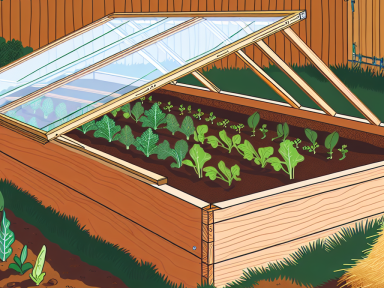Understanding Cold Frame Gardening
Cold frame gardening is a remarkable technique for extending your growing season, protecting delicate seedlings, and allowing for winter harvests. Here, we delve into the nuts and bolts of making the most of your cold frame.
What is a Cold Frame?
A cold frame is a simple, unheated, outdoor structure with a transparent lid. Its primary purpose is to capture and retain solar warmth, creating a microclimate several degrees warmer than the surrounding garden area.
Construction Tips
For optimal results, consider the following when constructing a cold frame:
- Materials: Use rot-resistant wood such as cedar or redwood for the frame. The lid should be made from materials like old windows, clear polycarbonate, or greenhouse-grade plastic.
- Dimensions: A height of 12″ at the front and 18″ at the back creates a desirable angle for maximum sun exposure. The dimensions can be adjusted based on your space and needs.
- Location: Place your cold frame in a sunny spot, ideally facing south. Ensure it’s sheltered from extreme winds to maximize heat retention.
- Ventilation: Prevent overheating by propping open the lid on warm days. Automated vent openers can simplify this task.
Using a Cold Frame
Starting Seeds
Cold frames are perfect for starting seeds earlier in the season. Follow these steps for success:
- Soil Preparation: Use a high-quality seed-starting mix. Ensure good drainage by adding sand or perlite if necessary.
- Sowing Seeds: Sow seeds in rows or trays within the frame. Water gently to avoid washing seeds away.
- Temperature Monitoring: Check the temperature frequently. Keep it between 65-75°F during the day, and don’t let it drop below 40°F at night.
- Hardening Off: Gradually expose seedlings to outdoor conditions before transplanting them in the garden.
Extending the Growing Season
Extend your growing season both in spring and fall. Here’s how:
- Spring: Begin planting cool-season vegetables like lettuce, spinach, and radishes several weeks earlier than usual. The cold frame provides the warmth they need to thrive.
- Fall: Continue growing these same cool-season crops longer into the fall. You can even plant new seeds midseason to harvest into winter.
Winter Harvests
In milder climates, cold frames can provide fresh produce throughout winter. Consider these tips:
- Select Hardy Crops: Opt for winter-hardy greens like kale, mache, and mizuna. Root vegetables such as carrots and parsnips also store well in a cold frame.
- Supplemental Heat: On particularly cold nights, add extra insulation with straw bales around the cold frame’s exterior or a layer of floating row cover inside.
- Watering: Water sparingly to prevent the soil from freezing. Ensure the frame stays moist but not waterlogged.
Maintenance Tips
- Regular Monitoring: Check your cold frame daily for temperature, moisture, and pest control.
- Cleaning: Keep the lid clean to ensure maximum light penetration. Remove any debris and vegetation at the end of each season.
- Repairs: Fix any structural damage promptly to maintain the integrity of the frame.
By incorporating cold frames into your gardening routine, you not only extend your growing season but also enjoy fresh produce almost year-round.



GIPHY App Key not set. Please check settings